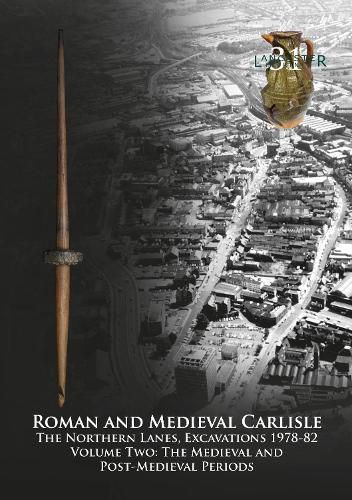Readings Newsletter
Become a Readings Member to make your shopping experience even easier.
Sign in or sign up for free!
You’re not far away from qualifying for FREE standard shipping within Australia
You’ve qualified for FREE standard shipping within Australia
The cart is loading…






Carlisle City Council redeveloped the Lanes from the mid-1970s, a densely built-up area in the north-east corner of the city’s historic core, crossed by 19 narrow ‘vennels’. These, together with most of the adjacent buildings, were swept away by the construction of the Lanes shopping centre. Previous archaeological work had confirmed complex Roman and medieval deposits on the site, most of which would be destroyed by the development, and many of the buildings were of historical and architectural interest. A programme of archaeological and historical investigation, including building recording, was therefore undertaken, principally funded by Carlisle City Council, the Department of the Environment (now Historic England), and the Manpower Services Commission, completed between 1978 and 1982. Historic England also funded the post-excavation analysis and this publication. The Lanes remains one of the largest and most significant archaeological projects ever undertaken in northern England.
The project was split into the northern and southern Lanes, the results of the latter being published in 2000, though it only included a summary of the standing-building survey. This volume, the companion to the 2019 publication of the Roman remains at the northern site, presents the evidence for post-Roman activity. The site appears to have been abandoned by the fifth century, layers of ‘dark earth’ accumulating over the latest Roman levels. Several decades after Carlisle was re-established by William II, narrow burgage plots were created, extending from Scotch Street to the recently constructed city wall. These were intensively occupied from then on and yielded a wealth of evidence for the everyday lives of the inhabitants. Around the mid-thirteenth century, the lanes themselves were created between these plots, probably to improve access, and this distinctive pattern of land-use persisted until the modern redevelopment.
$9.00 standard shipping within Australia
FREE standard shipping within Australia for orders over $100.00
Express & International shipping calculated at checkout
Carlisle City Council redeveloped the Lanes from the mid-1970s, a densely built-up area in the north-east corner of the city’s historic core, crossed by 19 narrow ‘vennels’. These, together with most of the adjacent buildings, were swept away by the construction of the Lanes shopping centre. Previous archaeological work had confirmed complex Roman and medieval deposits on the site, most of which would be destroyed by the development, and many of the buildings were of historical and architectural interest. A programme of archaeological and historical investigation, including building recording, was therefore undertaken, principally funded by Carlisle City Council, the Department of the Environment (now Historic England), and the Manpower Services Commission, completed between 1978 and 1982. Historic England also funded the post-excavation analysis and this publication. The Lanes remains one of the largest and most significant archaeological projects ever undertaken in northern England.
The project was split into the northern and southern Lanes, the results of the latter being published in 2000, though it only included a summary of the standing-building survey. This volume, the companion to the 2019 publication of the Roman remains at the northern site, presents the evidence for post-Roman activity. The site appears to have been abandoned by the fifth century, layers of ‘dark earth’ accumulating over the latest Roman levels. Several decades after Carlisle was re-established by William II, narrow burgage plots were created, extending from Scotch Street to the recently constructed city wall. These were intensively occupied from then on and yielded a wealth of evidence for the everyday lives of the inhabitants. Around the mid-thirteenth century, the lanes themselves were created between these plots, probably to improve access, and this distinctive pattern of land-use persisted until the modern redevelopment.